
- Home
- News
- Analysis
- States
- Perspective
- Videos
- Education
- Entertainment
- Elections
- World Cup 2023
- Features
- Health
- Business
- Series
- Economy Series
- Earth Day
- Kashmir’s Frozen Turbulence
- India@75
- The legend of Ramjanmabhoomi
- Liberalisation@30
- How to tame a dragon
- Celebrating biodiversity
- Farm Matters
- 50 days of solitude
- Bringing Migrants Home
- Budget 2020
- Jharkhand Votes
- The Federal Investigates
- The Federal Impact
- Vanishing Sand
- Gandhi @ 150
- Andhra Today
- Field report
- Operation Gulmarg
- Pandemic @1 Mn in India
- The Federal Year-End
- The Zero Year
- Premium
- Science
- Brand studio
- Home
- NewsNews
- Analysis
- StatesStates
- PerspectivePerspective
- VideosVideos
- Entertainment
- ElectionsElections
- Sports
- Loading...
Sports - Features
- BusinessBusiness
- Premium
- Loading...
Premium
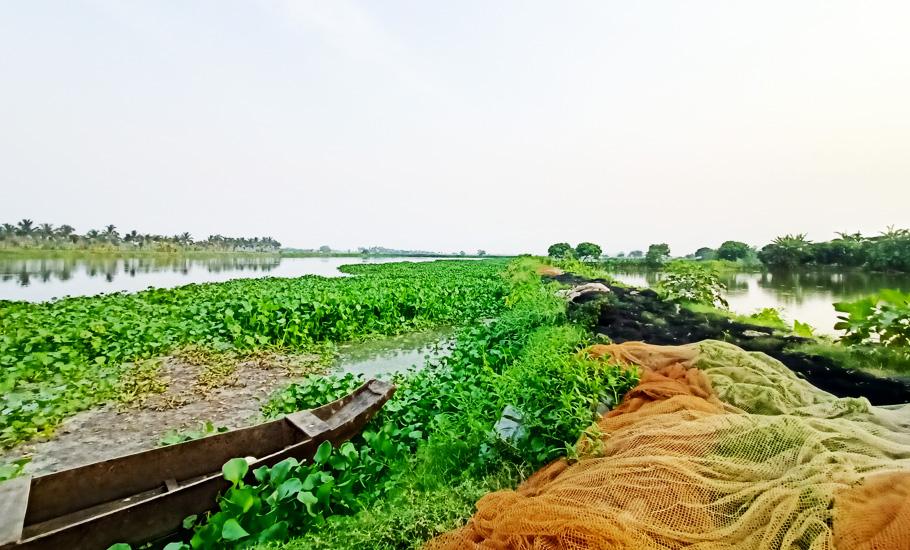
The Kolkata wetlands trail: The beauty and neglect a solo traveller found on the way

It is 38 degree Celsius this week, slightly lower than the 42 degree heat stroke which Kolkata experienced this year. I stepped out of my apartment with a palpitating uneasiness, the feeling of breathing inside a heat pocket or the concrete urban heat island to a much cooler zone, the East Kolkata Wetlands. A unique ecosystem of water bodies acting as a natural purification system for...
It is 38 degree Celsius this week, slightly lower than the 42 degree heat stroke which Kolkata experienced this year. I stepped out of my apartment with a palpitating uneasiness, the feeling of breathing inside a heat pocket or the concrete urban heat island to a much cooler zone, the East Kolkata Wetlands. A unique ecosystem of water bodies acting as a natural purification system for the city’s waste water treatment, which was given the status of Ramsar site in 2002. Kolkata city is home to a natural body of wetlands such as like the East Kolkata Wetlands, Santragachi Jheel Wetlands, Dankuni Wetlands and Rajarhat Wetlands that sustain its people and a huge biodiversity.
From a distance, the garbage hill was always visible on the highway leading to Sector V known as Dhapa. But never had I imagined that it was home to 12,500 hectare of organic sewage recycling system that treats almost 750 million litres of everyday sewage with UV radiation within a cycle of 20 days. EKW consists of salt water bodies, Bheries, pukur or settling ponds, sewage canals, vegetable farms, paddy, jute and rice fields, salt meadows, intertidal marshes, oxidation basins, sewage farms, shallow fishing ponds, dumping grounds, long stretches of coconut and palm trees, interconnected villages, nutrient rich cultivated land for cattle to graze and flora and fauna to thrive.
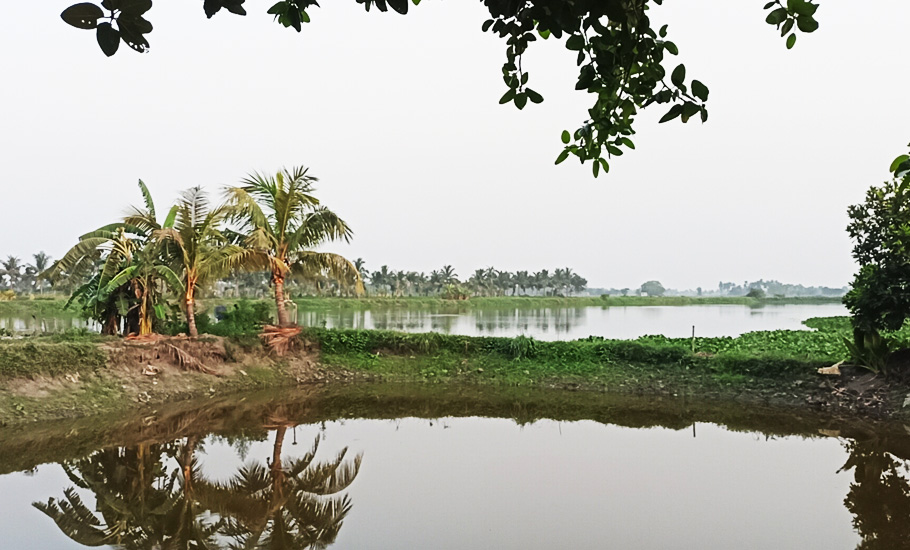
In a city that is constantly taking up more space for urbanisation, EKW provides a natural retreat for those searching for endless open grounds to reconnect their restless souls with the simplicity of people and nature. Growing up in the city with high rises, billboards, bridges, cars, markets, pollution, poor civic sense, miles of concrete, rising temperatures, shorter rainfall and struggling with both internal and external noise, I searched for places to ease my anxious mind. While being a naturalist at heart, I was set on a path to find natural spots in my city to encounter and incorporate in my creative work.
Also read: In pictures | Raghurajpur: Odisha’s walk-in gallery
There are no markers or gates to the entry points of EKW on the highway since the city people know very little about its existence and its ecological value to their low-cost food source and waste management. Dhrubajyoti Ghosh, a civil engineer and ecologist, who protected the wetlands and fought for its conservation throughout his life, had aimed to map EKW in the consciousness of the city people and the world. But more needs to be done to highlight its importance for ecotourism or as a tourist attraction to encourage hikers, nature enthusiasts, naturalists, bird watchers, wildlife photographers and explorers to access this heaven on their own.
Since EKW has a rich source of plants, fishes, insects and animals, young students and environmental enthusiasts can learn about the mechanism of this world and explore the possibilities of saving it from the burden of rapid urbanization and negligence.
Understanding its usage in our life can save this ecosystem and our city from drastic heat and floods in the future.
After asking the locals near Nalbal Park in Sector V, I am pointed towards one of the entrance near SDF mode via Ring Road by Rupa di who was returning from her housekeeping job nearby on a bicycle, she’ll be cycling back to Barokobad, her village just 2 kms away before the sun sets. Like so many locals, her family too has to depend on odd jobs, struggling to keep up with the rising inflation and making a living out of the rented or illegally possessed Bheries.
Another villager, Supriya di with a sad smile tells me that most Bheries or Pukurs are owned by outsiders, the fishing families are hired at times to look after them and paid a mere Rs 4,000 to Rs 5,000 a month and sometimes they make Rs 1,000 by catching mud fishes and sell in the markets. Since wetlands are drying up or at times fishermen have been falling prey to land encroachments without a way out, some of the families have been suffering silently. “Tomar naam khub sundor, you have a beautiful name,” she smiles heartily and walks back slowly towards Khetospur.
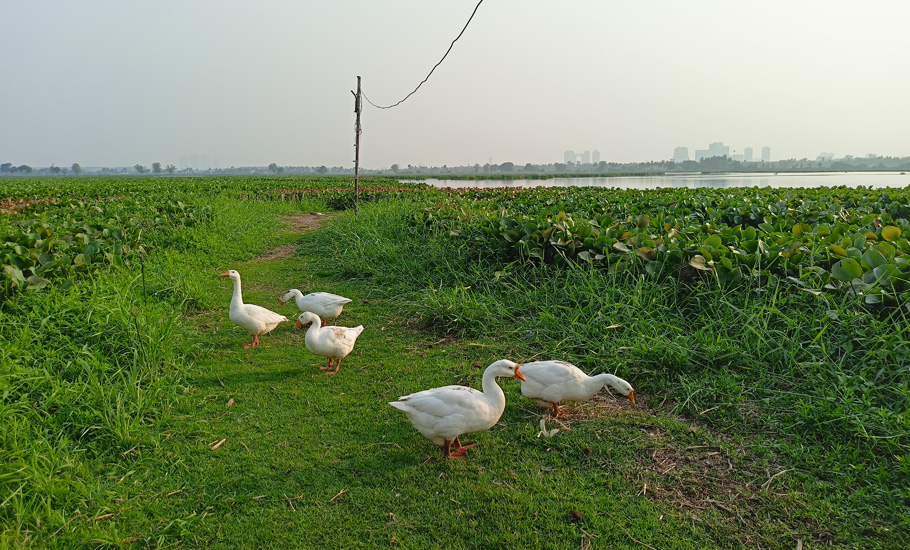
Between Nidtha Road Side Park and well paved sidewalk overlooking the large pond lined with coconut trees, a red dusted road leads to a part of the sewage ponds called Mosbaton Sodorpada. Like an inter-dimensional Universe, I am immediately transported from the busy commercial hub, noisy eateries, chai stalls and over-crawling buses to sprawling coconut trees and opaque emerald large ponds reflecting the afternoon sun. You will experience a different kind of quiet and stillness in this part of the world, a stillness your heart feels when you find breathing places when you are painfully weighed down by life. A quiet surrounded by chirpings of birds and village life your soul longs for in the long stretched summers.
I walked for the next 5 to 6 kms of small rocky lanes, uneven dirt tracks; unpaved trail with slight depression on the ground, through small wet bodies and villages, wooden bridges connecting the huts to the Bheries and embankments embedded with grass and flowers in utter astonishment, such beauty exists in a concrete city. I gleefully spot cows, dogs, goats and pigs roaming around with elderly people. Some fishermen post work rest inside small thatched huts by the pond, some women collect plastic and vegetables on their way back home, some men smoke biddi and untangle the fishing nets for the next day’s catch, some farmers are returning home and some elderly are sleeping on the mats, tired from working in the fields in the cool breeze floating through the landscape.
The landscape is layered with ponds after ponds on both sides of the walkway, trees of yellow and red flowers act as a resting spot, some women pick cabbages and take the goats home, some women unwind their task of the day from the rice fields, some wash utensils inside their huts and prepare for dinner, children play with tyres and swings attached to the trees, young girls cycle back from school and boats float in the water as the sun sets here.
I had fallen in love with the wetlands two years back, when I had visited Bheris like Saheb Mara and Goltola, exploring the scented colourful bougainvillea trail, the fishes in the pond, the birds diving in for a catch, the boatmen throwing in the nets, the children dunking in the ponds to swim and play, the dogs that had followed me to the village nearby, the simple minded villagers, the old women singing songs for their beloved land and the old ruin, one of the markers of the wetlands, the dilapidated part of sewage treatment plant which the British had built there long ago.
I had explored the fisheries with the group, since all of us had kept walking post sunset inside the village, having got lost a bit and looking for a way out. These marshes were home to the villagers, homes of farmers and fishermen and they knew its movement, its heart, its trail like the back of their hands. They lived in this space without GPS, without maps or lined routes, without telephones or proper drinking water or electricity, they lived here in the heart of nature, serving their purpose and giving back to nature. Whereas we on the other hand have always been taking from it, the wetlands’ people have been giving back to it with their sweat and poverty-stricken lives.
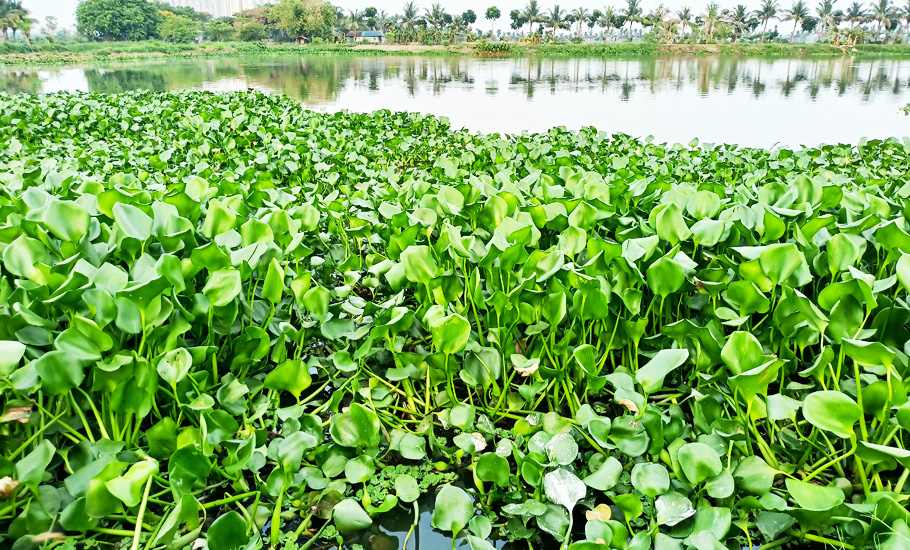
Kaku, a middle aged fisherman who lived in Chodtolla, doesn’t allow me inside one of the Bheries but politely tells me that the owner won’t like it, I obliged but I was keen for his insight about the fish growing in 260 ponds of EKW. Catla, Rui, Marigel, Bata, Silver and Grass Carp, Telapia, Nilotica, Magur, Bhetki, Parse, Murala, Punti, Tangra, Sol, Lata, Singhi, Koi, Ranga Chanda,Galda Chingri, etc, the variety of fishes were endless. Usually since the ponds have an enormous plankton growth from the wastes, the fishes feed on these plankton and keep the ponds surface clean and get treated by UV rays in the process.
The way the system worked here is what drew my attention to EKW. Kolkata’s markets are supplied with about 150 tonnes of fresh vegetables every day, 13,000 tonnes of fishes and almost 15,000 tonnes of paddy annually. It is fascinating how the simple fishermen and farmers have been working hard to provide the city with 40 to 50% of its major food source.
Near the bamboo pier at the one of the Bheris near the hut that had felt like a scene from The Malgudi Days story, I had spotted a Kingfisher and a Black-headed Gull basking in the sun. This place is the hotspot for bird watchers and wildlife photographers who during migration season, can find birds like Stork-Billed White Egrets, Long-tailed Shrike, Baya Weaver, White Wagtail, Indian darter, Taiga Flycatcher, Eurasian Cuckoo, Barn swallow, Yellow-footed Green pigeon, Brown-headed gull, Eurasian Coot, birds munias, buntings and a variety of ducks breeding there. But through the year, one can spot different species of birds, insects and flower plants in this oasis.
There are several groups of cyclists, walking groups and birdwatchers exploring this space but the lack of required information or mapping of the routes often leaves solo travelers puzzled. With the scorching heat this year, none of the groups are organising tours to the region. No individual is willing to help with information of the access points, without hefty amounts for organised tours to the wetlands. I was left at the mercy of my wits to explore the trail thereafter, since it is something people should acknowledge, preserve and enjoy freely.
Given the best time to explore the wetlands is summer and winter early hours or evenings, it is advisable to avoid it in the rains to save yourself from possible accidents, since the wetlands have a thriving population of snakes like buffed striped keelback, olive keelback water snake, dog faced water snake, common smooth water snake, Indian rat snake, ornamental flying snake, banded khukri snake, banded krait, common bronze back tree snake, monocellate cobra, russell’s viper, mammals like Asian palm civet, Bengal marsh mongoose, Asiatic jackal, fishing cats, palm squirrels, greater bandicoot rat, greater short-nosed fruit bat, Indian Pipistrelle and a variety of mongoose.
For wildlife enthusiast and photographers can find and study amphibians like ornate narrow mouthed frog, Indian painted frog, skittering frog, green pong frog, reptiles like common garden lizard, Brooke’s Gecko, bronze grass skink, white spotted supple skink, water monitor lizard, yellow monitor lizard, Indian flap shell turtle, marbled toad, common Indian toad, Indian bull frog, etc in the dense marshes.
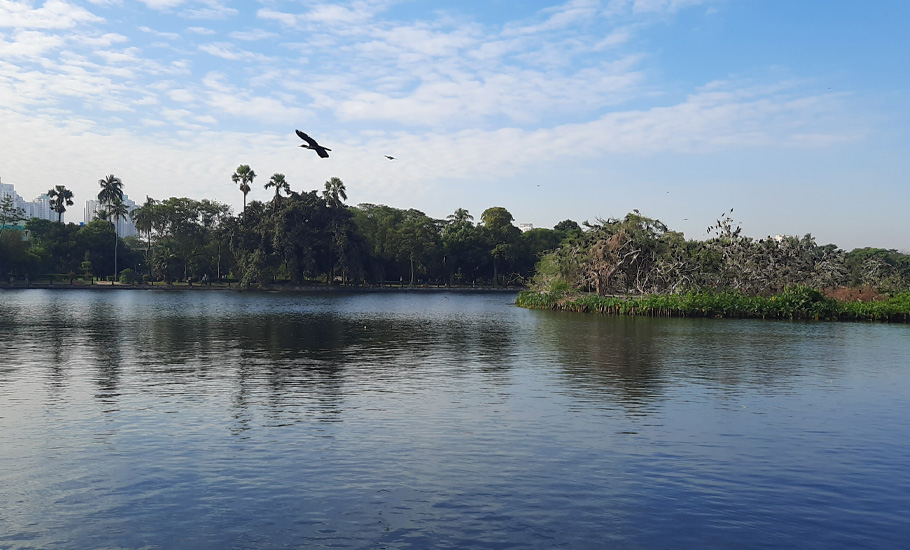
If you can overcome your inhibition of navigating a place without any GPS route or map and explore on foot for miles to experience their way of life, you can fall in love with the wetlands in our city. While watching the fish boats make their way home at Natar Bheril, through the long stretch of lavender water hyacinths, I walk past the ponds and the setting sun towards the city again but I find a calm feeling inside me and a promise to return to this place again.

